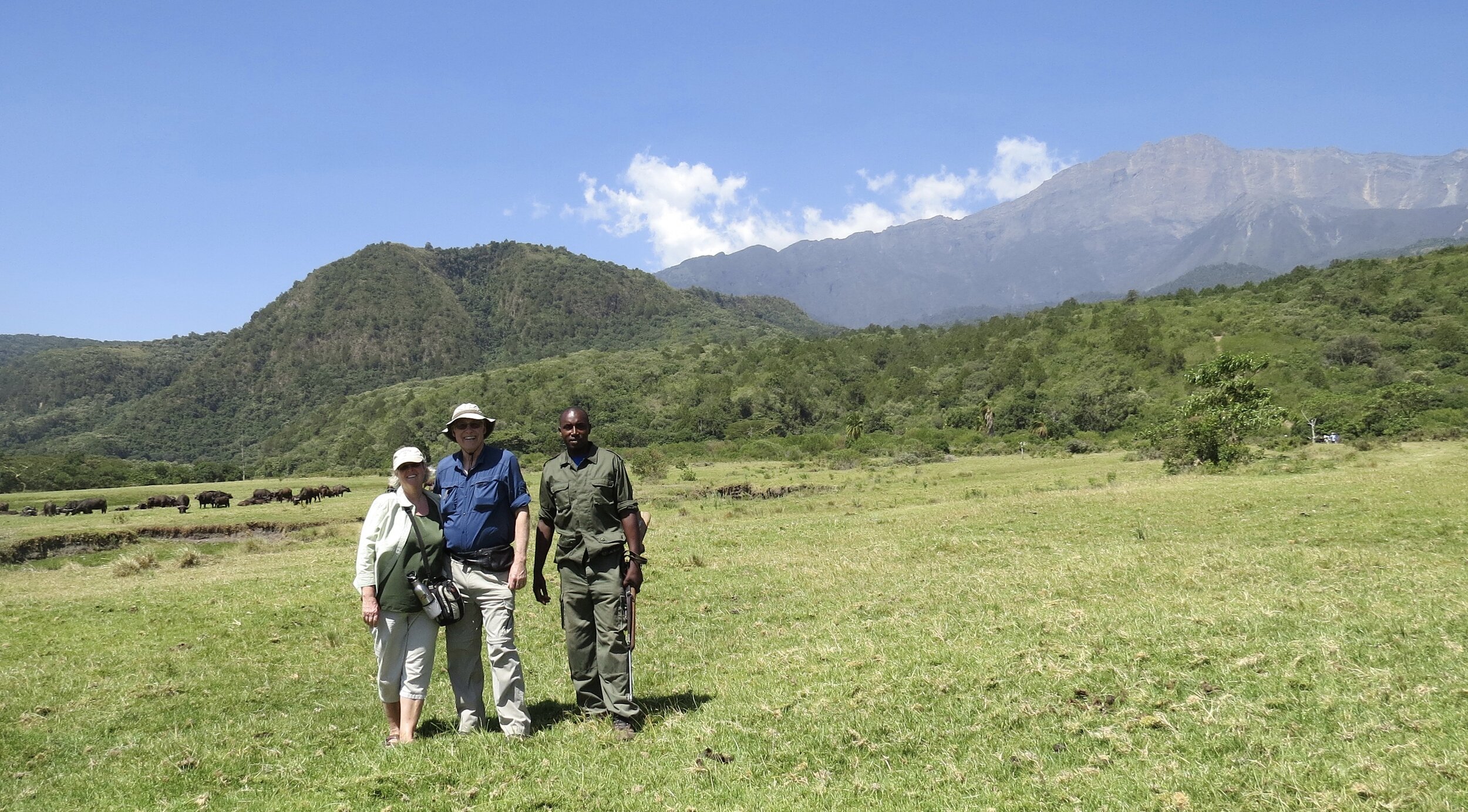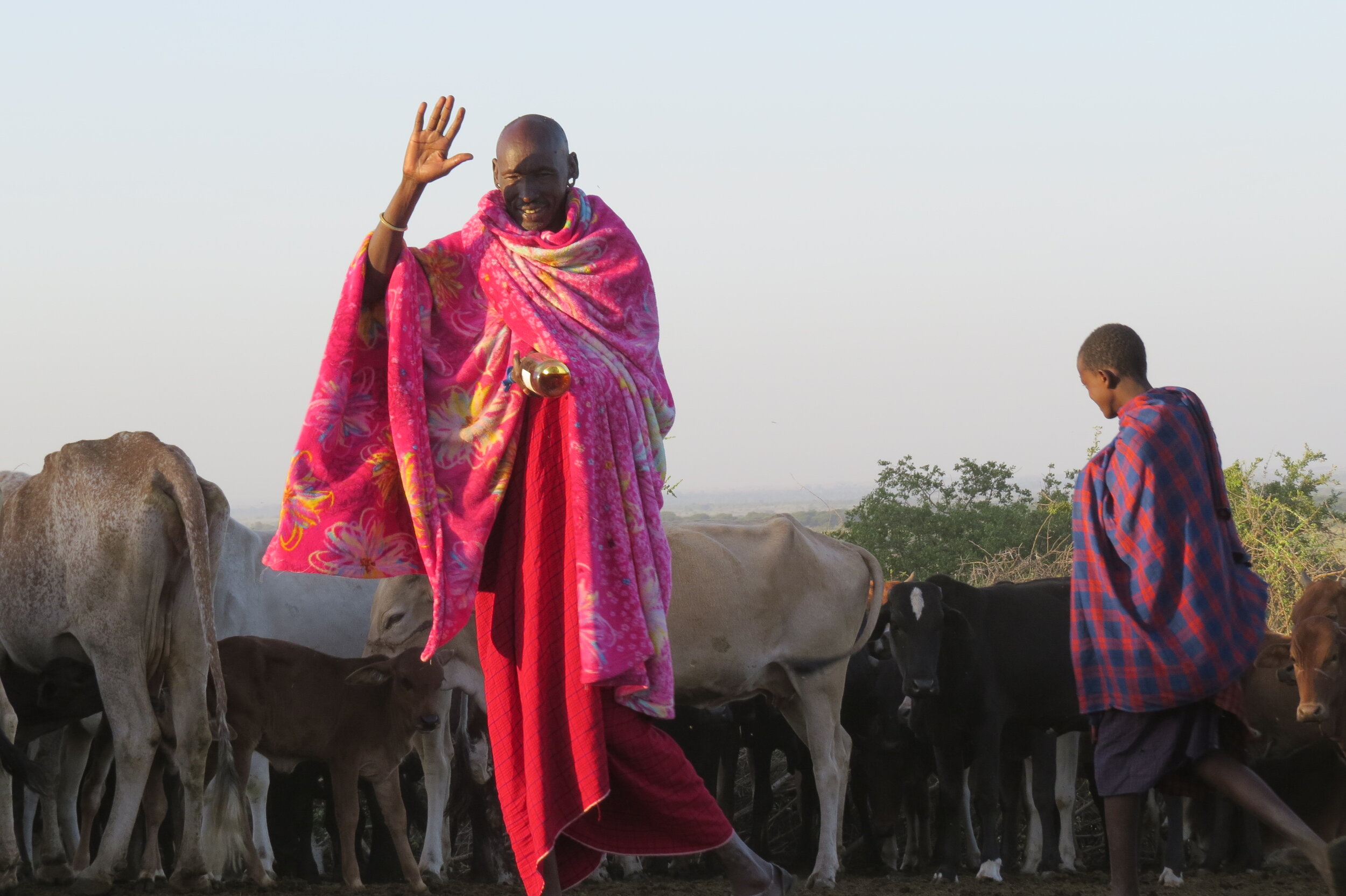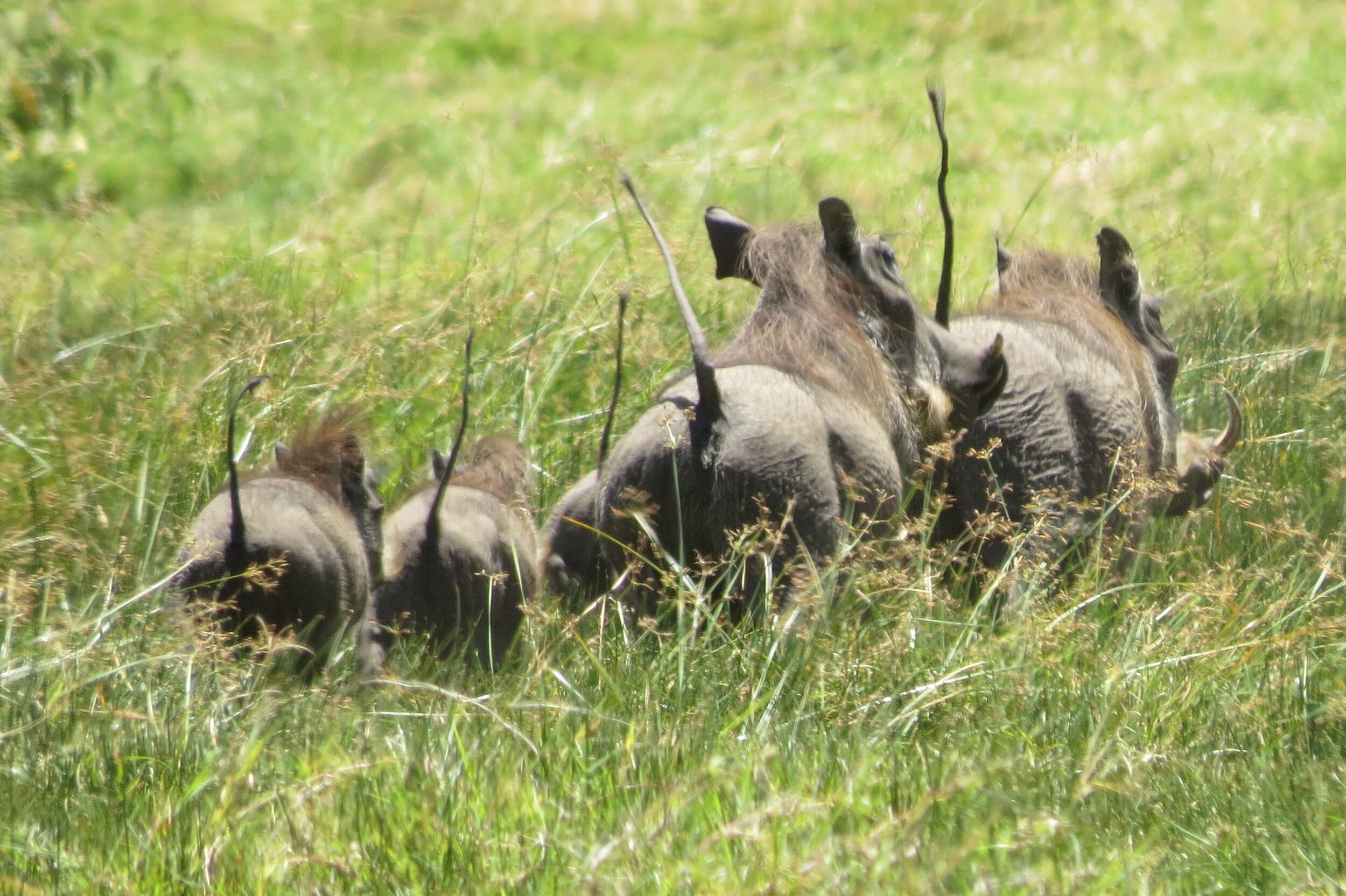Africa! For more than 40 years we have dreamed of coming here. Working as park ranger and in a primate center, Africa was always of interest to us. We read books about African adventures, animals and parks. Yet we were never actually able to go to Africa.
Until now. Three weeks of school visits help realize this dream. We flew from Dar Es Salaam, where it was incredible hot and humid, in a tiny airplane to Zanzibar. There we changed to a larger 12 seater which flew us back to the mainland, across the plains and to the hills of northern Tanzania to the town of Arusha.
Thanks to Mambulu Travel (https://www.mambulu.com), a small personalized travel agency in The Netherlands, we were able to compose an itinerary that allows us to explore the specific places we want to see, and to experience the parks and wildlife of Africa based on our budget.
We stayed in a wooden cabin clinging to the green hillside outside Arusha in the shadow of Mt Meru, Tanzania’s second highest mountain. Thanks to the option of a walking safari, we were able to walk in Arusha National Park. We saw large herds of buffalo, strolled among giraffes with a park ranger and spotted pink flamingo’s, colobus monkeys, elegantly crowned cranes and a large troop of baboons. We also managed to snap photos of other exotic birds and stately trees.
This area of Tanzania is very green and lush. We walked, together with a park ranger with a large rifle, to a 30 meter high waterfall. We picnicked overlooking Mammelo Lakes and visited a crater, like a small Ngorogoro, thick with green grass and herds of buffalo, before returning to our Arusha cabin.
Then our driver, Charles, picked us up for our trip into the heart of Tanzania. He is a nice, quiet young man and a cautious driver. He will be with us for the next 8 days or so. The best part is that our entire safari is just for the two of us - no large group in a bus, with Charles in a Jeep.
A long drive over beautiful, new pavement took us from Arusha to Tarangira National Park. The dusty, rusty entrance did not instil a sense of expectation. However, no sooner were we inside the safe boundaries of the reserve or we saw elephants: three young bulls, then a family herd of 20 or 30. Followed by yet another and another herd. Most with tiny new babies and elephants of all sizes. By the end of the afternoon we had seen hundreds of elephants. Amazing. And so heartening to know that there are still such safe holds for them. We also saw giraffes, zebras, a lion and two leopards. And of course the by now common bushbucks, waterbucks, and impala.
Giraffes in front of Mt. Kilimanjaro
At lunch, a monkey stole one lady’s sandwich. We watched it climb a tree, carefully peel off the plastic wrap and then pick out the tomato and lettuce, and throw those down before eating the rest.
We drove through Masaai land. A black paved road and a parallel running power line are two ugly scars across their traditional pastures. We spotted boma’s: an enclosure with small round huts, one for each family member. So you can tell from a distance if a man has two or three wives. Once, we passed a huge group of huts. Our guide laughed and told us “This man has married 22 wives. They now have many children and grandchildren, and even their own school.”
Maasai boma
Our fancy tent
Our tent camp for the night was a surprise: an open air shower, large private tents, even with a flush toilet, and a real safari mess tent, with a fire in front. We watched the setting sun, round and red over Lake Manyara, sitting in the mess tent and feel like we’re in an Out of Africa movie.… The music is that of birds and of clanging bells on many goats coming home for the night with their Masaai herder.
Early the next morning a young Masaai warrior took us to the nearby boma. When we arrived at the thorny gate, he removed a large bunch of branches with his stick. Masaai always have a stick in their hand. They use this almost as an extra limb to cope with rocks, uneven ground, animals, snakes, prodding goats and cattle, thorny bushes and much more. They receive their first stick around age 8 or 9, when the young boy becomes the goat herder - a most important job. They don’t seem to be able to part with their stick: we even see Masaai riding bicycles with their stick somehow in their hand.
Inside the enclosed circle of huts to the right is the house of the first wife.
To the left are the houses of any subsequent wives and those of the young men. A house is constructed in about a week, with a frame of thin branches, stuffed with cow dung as insulation. This is plastered on the outside with a smooth finish of earth obtained from termite hills mixed with cow dung and water.
The cows are in their own separate boma, as well as the goats, each protected by more thorny branches.
The Masaai are probably one of very few cultures left who live such a traditional lifestyle. No TV or any other modern conveniences. They are no longer nomadic but live a very primitive life which includes a strong hierarchy. After the boy becomes a goat herder, he will become a warrior at age 15 when he is circumcised. He then has to go off into the bush for 2 or 3 months, all by himself, without water or food but with a cow. The Masaai still drink milk mixed with blood. After he returns - originally this included the killing of a lion but that is no longer done because of conservation policies - he is ready to marry the woman his elders chose for him. As a man becomes wealthier, he needs more wives to give him children who will look after the cattle. The more sons, the more cows he can own.
“Our family has 30 cows,” our young guide told us, “we are considered a poor family. A wealthy man may have 3,000 cows!”
Our guide wore sandals made from motorbike tires - very strong and helpful to navigate the many sharp rocks on the savannah.
We enjoyed learning from one young Masaai man who was a guide. He told us in detail how he and 14 other young men from his village, set off into the bush for their coming of age initiation. Each brings a cow. They burn a stick into a spear and that is all they own. They may face lions, or elephants or any other dangers. And they live solely on blood, milk and meat. No water. But also no alcohol, no women. These young men dress in black blankets, for this special period, and have faces painted black with white stripes. We see them, occasionally, on the side of the road as they wander the countryside. They have strict rules of conduct and serve almost as wildlife wardens when they see any poaching or illegal hunting.
Note that her hair is covered in flies…
This young man, who was a waiter at the camp, told us he wants to be an animal doctor. He has vast knowledge of traditional medicine and wants to learn more about modern medicine for animals. He has a meeting at the college in Arusha soon to see if they will let him continue his studies. “But I may have to sell another cow to have enough money,” he adds wistfully.
Young children peeked out of the boma. We entered one and saw a small fire pit in the centre (no roof hole for smoke to escape, so very dark and smoky inside), a sitting bench build into the wall and a bed constructed of branches, lined with a cow hide. On the wall was one peg holding a large beadwork collar. A gourd was hanging on the wall and used to collect water, milk or blood. That was the extent of their earthly possessions.
The Masaai do not hunt and they do not grow crops. So their impact on the environment is very low. Our guide told us he had gone to school in a town. “I was so surprised,” he said, “to see people eating vegetables! And fish!” He grinned and said he tried vegetables but did not like them very much… A typical Maasai diet consists of ugali, corn meal mush with milk, for breakfast. More ugali for lunch and ugali for dinner, sometimes with meat if and when the family can afford to butcher and roast a goat.
Cultural differences are so fascinating around the world. The Maasai are very hospitable and offer a bed to any visiting warriors. However, the husband leaves the boma while the woman stays. It is her decision as to whether she wants to sleep with the visitor. This rule, too, is because of the high infant mortality rate….
As we strolled around the boma, the young women produced necklaces and bracelets. We bought a large one of intricate beadwork, for about 20.-
The rest of the day we drove around Lake Manyara National Park and spotted our first wildebeest. We also saw lots of baboons, giraffes, elephants and other animals in this beautiful lush green park where steep slopes of the escarpment meets the flat surface of the lake bed.
That night, just before sunset, the Maasai came to dance for us. Tall skinny men and a bunch of young girls, all wearing brightly colored shukas (blankets) and the girls with their round beaded necklaces. The dances consisted mostly of high jumps by the men, and the girls deciding who was the best jumper. There was much chanting and laughing and the colors, in the setting sun, were breathtaking. We felt very honoured that they danced, just for us.
Before we left we made a donation to the Lodge’s African Roots Foundation. With very little money they make a huge difference in the lives of the Maasai by supplying them with water containers and a filter. Where the Maasai used to rely on thick brown water from a nearby pond, from which all cattle also drink, they now scoop that water into filters and have crystal clear drinking water. This simple tool has drastically reduced illness among the Maasai.
ARF also runs other projects, always aimed at improving the lives of people while protecting the natural environment. This is a great cause for individuals and schools to support.
Check out: https://www.facebook.com/Africanrootsfoundation/
Our Tanzania adventure will continue in a next Tanzania post when we visit the Serengeti.
To learn more about the Maasai people and culture, click here: http://www.maasai-association.org/maasai.html
For our favourite books about Tanzania, click here: BOOKS


















